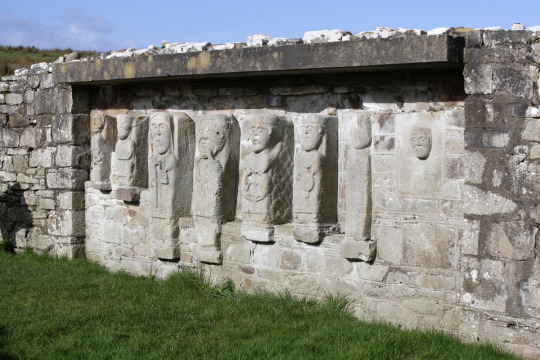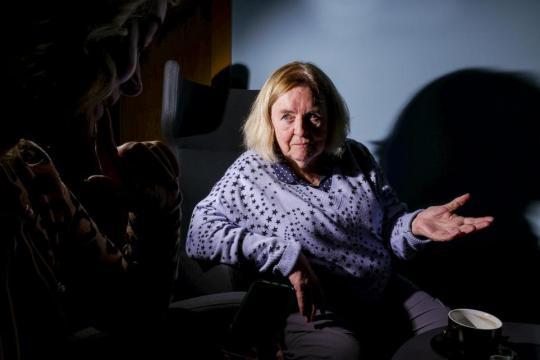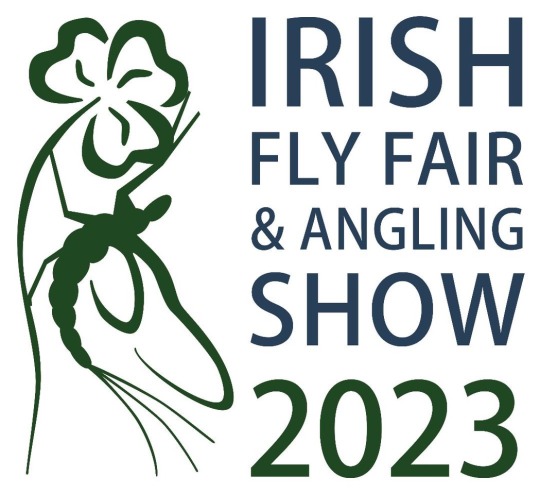#Co. Fermanagh
Explore tagged Tumblr posts
Text
White Island, Lower Lough Erne, Co Fermanagh
Situated in Castle Archdale Bay off the east shore of Lower Lough Erne; the ruins of an ancient church are found near the shore, built on the site of an earlier monastic settlement. It still has an intact arched Romanesque doorway. The ruined church on the island has a reconstructed plain Romanesque doorway. Secured to the north side of the south wall are eight carvings (seven figures and one…

View On WordPress
#Co. Fermanagh#Eight Figures#History#History of Ireland#Ireland#Irish History#Lower Lough Erne#Sheela-na-gig#Sheelas#Vikings#White Island Church Site
10 notes
·
View notes
Text

Enniskillen Castle, principal fortress of the Maguire clan to 1585 when it was captured by the English. Of the Maguire tower house of 1428 only the lower level survives. It was significantly remodelled by Captain William Cole from 1607 and the 'water gate' with its Scottish corbeled bartizans added. Its last major remodelling was ijust before the Napoleonic period when it was converted to a military barracks (1796). it kept that function to 1950 and now houses a regimental museum and the Fermanagh County Museum. Both, as well as the castle, well worth the visit.
3 notes
·
View notes
Text
Had a dream last night about the paper I'm writing for class rn (which, for reference, has to do with religion in the north of ireland in the eighteenth century) where I found a primary source (think it was meant to be someone's journal? idk) which described how there used to be a job exclusive to co. fermanagh which was very well paid (who paid you was never specified) but consisted solely of getting up every sunday and holy day in the winter (it was very specifically only in the winter) and going to mass and then coming back and pointedly talking about it all day to shame your neighbours who had deemed it too cold (????????) to go, and then staying in bed all day every other day of the week (this was also very very important to it for some reason). ofc this is definitely not true at all and I don't know why my brain is making up fake facets of the 18thc irish catholic church now but it's the funniest concept ever to me. paid enforcer of catholic guilt who gets to go sleepies all the time. bye mum
13 notes
·
View notes
Text
IRA volunteers arm checkpoint Co. Fermanagh 1972

8 notes
·
View notes
Text
youtube
Margaret Gallagher - it's my solitude, it's my comfort, authentic thatch living in Co. Fermanagh
Documentary I produced for the BBC in 1992 that has proven to be very popular from its first broadcast and continues to attract interest from across the world in 2022. Margaret Gallagher from Belcoo, County Fermanagh, N. Ireland enjoys her rural lifestyle, living without modern amenities. This was shot on 16mm film.
It reached one million views by June 2019 without any advertising and those numbers continue to climb in 2021. Fantastic! Many thanks to all viewers and especially those who have left such kind comments. I've been in touch with Margaret and she is thrilled at the response.
John Callister
youtube
1 note
·
View note
Photo

Bernadette Devlin McAliskey is still these things and more, being a force for radical politics in the north of Ireland throughout her life. This image is from a 2023 interview, for a County Fermanagh paper she's also written for. You'll find many more of her at protests or in crowds, at all times of her life. She's advocated for migrant workers for decades as a co-founder for STEP (South Tyrone Empowerment Programme). She agitates for housing rights, women's rights, trans rights, prisoners and sex workers; for a truly socialist society in Ireland and worldwide.
You need only flick though her Wikipedia page to see how she's fought, what she's survived - and appreciate how glad we should be to learn from her experience now. You can listen to her in this 2018 episode of the Blindboy Podcast, countless clips on YouTube from RTÉ, socialist groups, academic lectures, pro-choice movements - she's still organising, speaking, fighting for a socialist world at 78.
I've embedded a clip from the last link here - please give it a listen, then spare an hour and treat yourself to the whole talk. The way she can bring together autonomy, humanity, and solidarity - in words and deeds, for people and movements, as the most natural thing in the world - is so incredible. Irish feminism is absolutely a tradition we can never learn enough from, and the message of community care for each other is one we need more than ever today.
youtube



Bernadette Devlin was an Irish feminist, socialist, and republican, and at age 21, she became the youngest female Member of Parliament. She spoke passionately, eloquently, intelligently, and unforgivingly in support of Catholics during the civil rights movement in Northern Ireland. In 1969, after the keys to New York City were presented to her, Devlin gave them to the Black Panther Party, because she better identified with them and their plight than with the conservative Irish-Americans she had met on her visit to the U.S. In 1972, the British Home Secretary made a defense for the British soldiers who shot 26 unarmed Irish civilians during the Bogside Massacre. In the middle of his speech, Devlin stood up and punched him. She stated that it was “coldly, and calmly done” and that she did it to deliver “a simple, proletarian protest.” When asked if she was going to apologize, she responded, “I’m just sorry I didn’t get him by the throat.”
#feminism#socialism#ireland#human rights#abortion rights#bernadette mcaliskey#bernadette devlin#Youtube
11K notes
·
View notes
Text
I didnt need to sleep tonight anyway
1 note
·
View note
Text
Pollnagollum Cave, Co. Fermanagh
0 notes
Link

1 note
·
View note
Text
January God
In ancient Roman religion and mythology, Janus is the god of beginnings and transitions, thence also of gates, doors, doorways, endings and time. He is usually a two-faced god since he looks to the future and the past. The Romans dedicated the month of January to Janus. His most apparent remnant in modern culture is his namesake, the month of January. The Nobel Prize winning poet, Seamus Heaney,…

View On WordPress
#&039;January God&039;#Ancient Irish History#Ancient Roman Religion#Boa Island#Co. Fermanagh#Eniskillin#From Cruach#Ireland#Irish History#January#Janus Figure#Mythology#Seamus Heaney#The Secret of Kells
13 notes
·
View notes
Text

www.Marksoftime.com
Tully Castle, Co Fermanagh. Built 1619 part of the Plantation of Ulster for John Hume of Berwick . A T shaped fortified house surrounded by a stone bawn wall with projecting circular stepped bartizans in the Scottish style.
0 notes
Text
0 notes
Text
Irish Fly Fair 2023
On the 18th -19th of November I will be tying at the 11th Irish Fly Fair at the Killyhevlin Hotel, Enniskillen, Co. Fermanagh in Northern Ireland. This well loved show has returned at last after Covid. If you are attending the show, I will have a limited amount of my last two English language books with me, so if you would like to use this opportunity to pick up a signed copy, call by my…

View On WordPress
0 notes
Link
The PSNI said they may be with their parents, Kathleen and Martin Maughan.
0 notes
Link
[ad_1] Walking down the Glen Road in nationalist west Belfast a month after his release from prison on Valentine’s Day, 1986, Seamus Kearney made his mother a promise.She told Kearney she had a job for him: she wanted him to find out what happened to his younger brother, Michael.“I need you to find out if he was an informer,” she told her son.Michael Kearney joined the Provisional IRA in 1978. Within a year, the 20-year-old was dead. In July 1979 he was killed and left on a roadside in Co Fermanagh. The IRA released a statement claiming he had been “executed” because he was an informer.I said: ‘Who the hell’s he? Is he an ice-cream man?’ I was told that he was [IRA] internal security unit... That was the first time I heard his name. It was 1986— Seamus Kearney on Freddie Scappaticci“I told my mother I probably would have shot him myself if he was an informer. She wasn’t a republican but said she understood. She asked me to get the truth before she died,” says Seamus Kearney, a former IRA member who served almost 10 years of a 14-year sentence for the attempted killing of an Ulster Defence Regiment (UDR) soldier.Beginning his search for answers about his brother’s final days, someone told him: “Michael was with Freddie Scappaticci.”“I said: ‘Who the hell’s he? Is he an ice-cream man?’ I was told that he was [IRA] internal security unit... That was the first time I heard his name. It was 1986,” Kearney told The Irish Times.StakenifeThe son of an Italian immigrant who ran an ice-cream van in the Markets area of Belfast, Freddie Scappaticci is at the centre of a £37 million (€43 million) independent investigation into his alleged role as the British military’s top IRA spy, Stakeknife.He denied he was the high-ranking double agent right until his death four months ago at the age of 77.Freddie Scappaticci denied he was the high-ranking double agent right until his death four months ago at the age of 77. With over 1,000 witness statements and more than one million pages of material gathered in the vast investigation, an interim report is expected to be released next month – seven years after former Bedfordshire chief constable Jon Boutcher agreed to oversee it.Named Operation Kenova, it is also examining the role of the British state in multiple murders connected to Stakeknife.It is thought Scappaticci was involved in up to 30 murders, including 18 where he directly carried out the killings; Michael Kearney’s abduction is among the first linked to the man known as “Scap”.[ Freddie Scappaticci obituary: IRA informer ‘Stakeknife’ was known as ‘jewel in the crown’ of British intelligence ]“My brother was interrogated by a British military officer... who was apparently the biggest British agent since the second World War. It adds a whole new layer,” said Seamus Kearney.Ask former IRA members in Belfast about Scappaticci today and there is silence.“It’s a taboo,” said one, “even with him dead.”‘Complete denial’As head of the Provisional IRA’s notorious internal security unit, known within the paramilitary organisation as the “nutting squad”, Scappaticci was responsible for identifying, kidnapping, and torturing informants or “touts” in the 1980s.Many relatives of those interrogated are reluctant to speak.“There is still a wall of silence,” said solicitor Kevin Winters, who represents 12 families who have co-operated with the Kenova investigation, including the Kearneys.“That’s because it is deeply uncomfortable for the republican movement and for Sinn Féin. Twenty years ago, there was a complete denial by senior figures when Scappaticci was outed. The stigma of ‘the tout’ and ‘the family of the tout’ still runs very deep. Notwithstanding the fact this man was a British agent, there is the residual suspicion and concern about sticking your head above the parapet.”Once described by a British Army general as the “golden egg” of British military intelligence during the three-decade Northern Ireland Troubles, Stakeknife was credited with saving “hundreds and hundreds of lives”.Others see his role differently, as the IRA man responsible for investigating and killing informers was himself an informer and may have killed, and had others killed, to protect his own status as a double agent.Freddie Scappaticci at the 1987 funeral of IRA man Larry Marley. Photograph: Pacemaker When he was named in the media in 2003, Scappaticci fled to England. Following the news coverage, he gave a press conference denying he was Stakeknife but left his west Belfast home weeks later. He lived under an assumed identity until his death.If Scappaticci was so senior, how come the IRA was able to carry out all the operations it was able to carry out at the time?— Danny Morrison“He betrayed his comrades, he betrayed his community. He was despised,” Danny Morrison, former Sinn Féin director of publicity, told The Irish Times. “There was no sympathy for him.”‘Stupid Paddys’In 1990, Morrison was sentenced to eight years in prison in relation to kidnap and conspiracy to murder IRA informer Sandy Lynch. That conviction was quashed by a Court of Appeal in 2008, though the State withheld its reasons for doing so.Morrison says Scappaticci was responsible for his arrest in 1990 – it was after this he was “stood down”, according to Morrison – but believes accounts of his seniority as an informer have been “exaggerated”.“If Scappaticci was so senior, how come the IRA was able to carry out all the operations it was able to carry out at the time? People who assume the IRA was so infiltrated that it was forced into a peace process – it’s so racist in a way as it’s assuming they’re all ‘stupid Paddys’,” he said.“Scappaticci was a paid agent, and, according to many accounts, had the power to get people killed who the IRA had suspected were informers. Regardless of my total opposition to British rule in Ireland, from a military intelligence point of view, presumably if someone’s working for you, you have a duty of care towards them,” said Morrison.“Instead, what they did, once a low-level agent had outlived his usefulness, they allowed Scappaticci to have that person killed in order to increase the prestige of Freddie Scappaticci as a spy-catcher. They knew that if someone is killed by the IRA inside the nationalist community, it is demoralising, it loses the IRA support among cousins, friends, family of that person. That was their strategy.”Danny Morrison at the funeral of former Sinn Féin general secretary Rita O'Hare at Glasnevin Cemetery, Dublin, in March of this year. He believes accounts of Freddie Scappaticci's seniority as an informer have been 'exaggerated'. Photograph: Niall Carson/PA The Kenova report is undergoing security checks but there are doubts over whether it will result in prosecutions.Publication will coincide with the expected passing of the UK government’s controversial legacy bill into law, which will effectively provide a conditional amnesty for those involved in Troubles-related crimes.Personally, I think the report will be a fudge. It’s too bloody ugly. I don’t think the British government will want people to see their real role in the conflict— Seamus Kearney on the Kenova reportConfirming Scappaticci’s death in April, Boutcher insisted that his team “remain committed to providing families with the truth of what happened to their loved ones and continue to actively pursue criminal charges against several individuals”. Extensive files have been submitted to Northern Ireland’s Public Prosecution Service (PPS) since 2019.“We also recognise that people may now feel more able to talk to the Kenova team following the death of Mr Scappaticci, who had long been accused by many of being involved in the kidnap, murder and torture of potential PIRA informants during The Troubles,” Boutcher said at the time, while issuing a further appeal for those with information to come forward.Jon Boutcher, the retired Bedfordshire chief constable in charge of Operation Kenova, the €43 million investigation into Scappaticci's activities, is expected to release an interim report into the double agent next month, seven years after he was appointed. Photograph: Liam McBurney/PA Wire ‘So many obstacles’Seamus Kearney is among the relatives of victims who have spoken to Boutcher and his team. They first met in 2016.“Jon Boutcher is well-intentioned. I have confidence he will try and get to the bottom of it. He wants to do the best but he has so many obstacles in his way,” says Kearney.“Personally, I think the report will be a fudge. It’s too bloody ugly. I don’t think the British government will want people to see their real role in the conflict. It was agents of the State who killed my brother. I don’t think there will be any prosecutions.”In an unprecedented move, Michael Kearney’s name was “cleared” in 2003 following an internal IRA investigation sparked by Seamus Kearney’s quest for the truth.[ Prosecutors continue to consider ‘Stakeknife’ files for charges against other suspects ]“The army [IRA] read out its report to me in the kitchen of a west Belfast house saying he wasn’t an informer,” Kearney says.It transpired that Michael Kearney was taken to Castlereagh Holding Centre in June 1979 and “broke” after three days, telling the Royal Ulster Constabulary (RUC) where a small quantity of explosives were stashed.They released him but didn’t charge him, which “put a target on him”, his brother said. He was subsequently “lifted” by Scappaticci and the IRA’s internal security unit, who drove him to a house in Dundalk where he was interrogated for 16 days. He was then taken to a remote border area and shot dead.Almost 20 years after making his promise to his mother Kathleen, Seamus Kearney went to see her at her home in Downpatrick and gave her the IRA report.‘Good name restored’“She asked where the apology was. I told her: ‘That is the best we’re going to get. They’re clearing his name.’“She was relieved but said it didn’t bring Michael back. I remember her saying: ‘I now can go to my grave knowing my son’s honour and good name have been restored,’” Kearney recalled.“We had a commemoration Mass for him in June 2003. There were over 1,000 people at it. People were told not to go to original funeral in 1979.”His mother died in 2010.Kearney, who has published a book, No Greater Love, about his life in the IRA and losing his younger brother, becomes emotional recalling his last conversation with his brother.Seamus Kearney was an IRA prisoner at the Maze at the time of his younger brother's murder. Photograph: Arthur Allison/Pacemaker Press It was March 1979 and Seamus had been “on the blanket” – a protest when the IRA refused to wear prison uniform – in the Maze/Long Kesh prison for two years; someone had told him his younger brother had joined the IRA. He requested that Michael visit him in the prison on his own.“I told him: ‘Get out of it [the IRA].’ He said: ‘I can’t, I have to help you.’”Seamus told his brother that the only way he could help was by focusing on his apprenticeship as an electrician and looking after their mother until he got out of prison.‘Wits’ end’“I told him he would end up in prison or dead. I was at my wits’ end,” he said.“The last words he said to me were: ‘Will you give me your blessing?’ I told him it would end in tears. I was trying to save his life. I was the older brother. He wouldn’t listen.”When the 30-minute visit was up, Kearney started walking back to his cell. He looked back and his brother turned back at the same time, each man catching the other’s gaze.“He nodded and I nodded,” said Kearney, “and that was it.” [ad_2]
0 notes
Text
FYI OP, regarding the countries mentioned in your tags:

Fionn Regan was born in Bray, Co Wicklow in 1981:

Wicklow is in Ireland, which separated from the UK with the signing of the Anglo-Irish Treaty of December 1921. By the time Regan was born, Ireland had been an independent country for sixty years. So he's not a UK artist. Six counties on the island of Ireland remained part of the UK after the signing of the Anglo-Irish Treaty: Fermanagh, Armagh, Tyrone, Derry, Antrim and Down. If an artist is from any of those counties, then they can be counted as both Irish and from the UK. Hope this helps.
Also fun fact, Bray is where Hozier is from!

#Irish music#Irish history#we've been an independent country for a while now#just btw#ireland#Bray of all places
24 notes
·
View notes